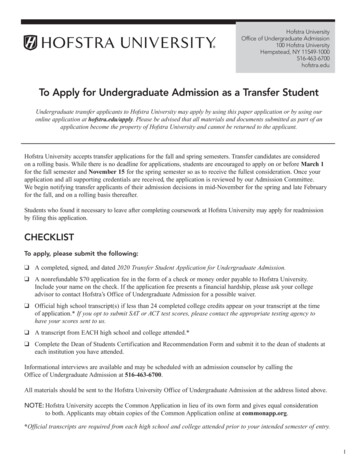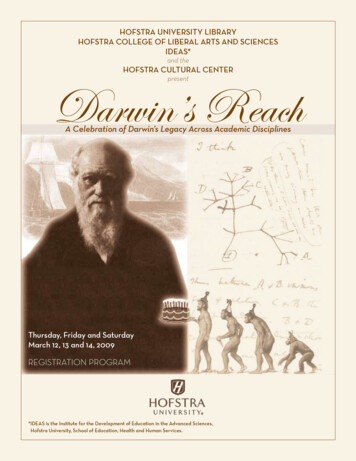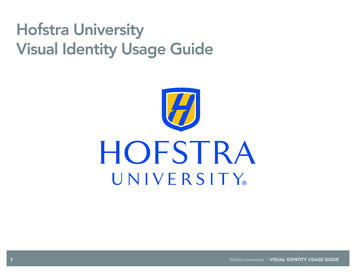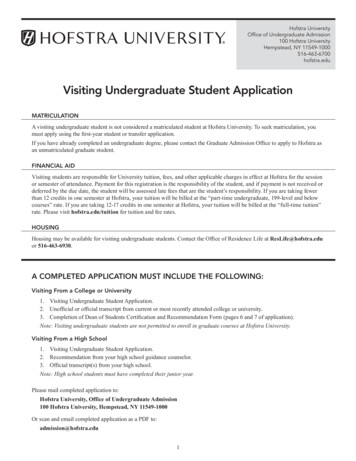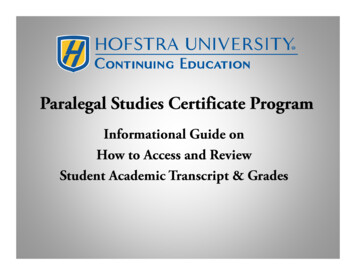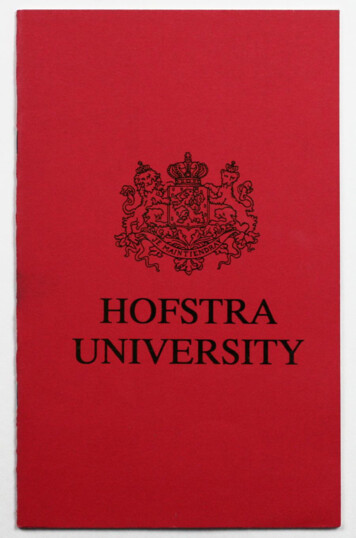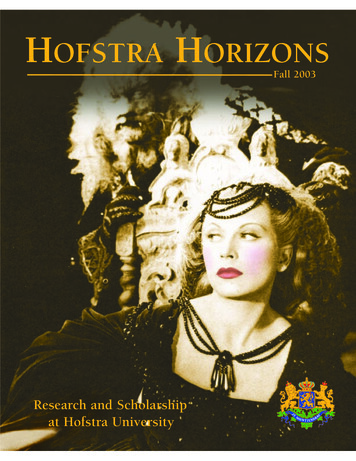
Transcription
HOFSTRA HORIZONSFall 2003Research and Scholarshipat Hofstra University
HOFSTRAAt A Glance2003-2004LOCATION: Nassau County, Long Island, 25 miles east of New York City. Telephone: (516) 463-6600.CHARACTER: A private, nonsectarian, coeducational university.FOUNDING DATE: 1935PRESIDENT: Stuart RabinowitzCOLLEGES AND SCHOOLS: Hofstra College of Liberal Arts and Sciences, Frank G. Zarb School of Business, School ofCommunication, School of Education and Allied Human Services, New College of Hofstra (innovative college), School of Law,School for University Studies, Honors College, Saturday College and University College for Continuing Education.FACULTY: There are 1,291 faculty members, of whom 507 are full-time. Ninety-one percent of full-time faculty hold the highestdegree in their fields.STUDENT BODY: Full-time undergraduate enrollment of 8,314. Total University enrollment, including part-time undergraduate,graduate and School of Law, is approximately 13,400. Male-female ratio is 43 to 57.UNDERGRADUATE DEGREE PROGRAMS: Approximately 130 undergraduate programs of study.GRADUATE DEGREE PROGRAMS: Approximately 140 graduate programs of study, including Ph.D., Ed.D., Psy.D. and J.D. programs.THE HOFSTRA CAMPUS: With 111 buildings and 240 acres, Hofstra is an accredited member of the American Association ofBotanical Gardens and Arboreta.HOFSTRA LIBRARIES: The Hofstra Libraries are fully computerized and contain 1.6 million volumes and volume equivalentsavailable for student use.ACCESSIBILITY: Hofstra is 100 percent accessible to persons with disabilities.JANUARY AND SUMMER SESSIONS: Hofstra offers a three-week January session, and three summer sessions between May andAugust.
HOFSTRA HORIZONSResearch and Scholarship at Hofstra UniversityFall 2003Table of ContentsGreetings From the President . . . . . . . . . . . . . . . . . . . . . . . . . . . . . . . . . . . . . . . . . . . . . . . . . . . . . 2Greetings From the Provost . . . . . . . . . . . . . . . . . . . . . . . . . . . . . . . . . . . . . . . . . . . . . . . . . . . . . . . 3Legitimate and Illicit Entrepreneurship: An Opinion Concerning theRelation of Convergent and Divergent Business Development Strategiesby Jeff Brice Jr. . . . . . . . . . . . . . . . . . . . . . . . . . . . . . . . . . . . . . . . . . . . . . . . . . . . . . . . . . . . . . . . 4Cocteau Films Come to Hofstraby David S. Pushkin. . . . . . . . . . . . . . . . . . . . . . . . . . . . . . . . . . . . . . . . . . . . . . . . . . . . . . . . . . . 8Women’s Ministry in the Catholic Churchby Phyllis Zagano . . . . . . . . . . . . . . . . . . . . . . . . . . . . . . . . . . . . . . . . . . . . . . . . . . . . . . . . . . . 11The Not So Lonely Lives of Hermit Crabs: Studies on Hermit Crab Symbiontsby Jason D. Williams. . . . . . . . . . . . . . . . . . . . . . . . . . . . . . . . . . . . . . . . . . . . . . . . . . . . . . . . . 15The Asian Studies Program at Hofstra University: Challenges and Opportunitiesby Patricia Welch . . . . . . . . . . . . . . . . . . . . . . . . . . . . . . . . . . . . . . . . . . . . . . . . . . . . . . . . . . . 19Grant News . . . . . . . . . . . . . . . . . . . . . . . . . . . . . . . . . . . . . . . . . . . . . . . . . . . . . . . . . . . . . . . . . . 22On the cover: Jean Marais and Josette Day from Beauty and the Beast (1946).HOFSTRA HORIZONS is published semiannually in the fall and spring by the Office for Research and Sponsored Programs, 144 Hofstra University, Hempstead,New York 11549-1440.Each issue describes in lay language some of the many research and creative activities conducted at Hofstra. The conclusions and opinions expressed by theinvestigators and writers are their own and do not necessarily reflect University policy. 2003 by Hofstra University in the United States. All rights reserved. No part of this publication may be reproduced without the consent of Hofstra University.Inquiries and requests for permission to reprint material should be addressed to: Editor, HOFSTRA HORIZONS, Office for Research and Sponsored Programs,144 Hofstra University, Hempstead, New York 11549-1440. Telephone: (516) 463-6810.
This has been an exceptionally exciting year at Hofstra University for manyreasons. We celebrated the opening of Hagedorn Hall, the new,technologically advanced home for the School of Education and AlliedHuman Services, and — that same week — received word that Hofstra is therecipient of a 11.5 million grant from the National Science Foundation!While much is new and newsworthy at Hofstra, we also continue to enjoy ourannual traditions. For example, as this issue of Hofstra Horizons goes to print,we will welcome thousands of prospective students to campus during FallOpen House.Another tradition at our fine university is this publication. Hofstra Horizonsprovides the academic community with thoughtful, scholarly essays andarticles. I am always impressed by the insightful, well-researched, andprovocative pieces included in this publication.The articles you will read in this issue of Hofstra Horizons once again reflect the dedication of our facultymembers to their scholarship and teaching. And that dedication is a tradition that will always benewsworthy.Congratulations to all contributors!Stuart RabinowitzPresident2
Excellence in teaching and scholarship are two cornerstones of HofstraUniversity’s fine reputation. More than 90 percent of our full-time facultymembers have attained the highest degrees in their fields. What make thesescholars outstanding teachers are the experiences and expertise they bring totheir classrooms. The articles in this issue of Hofstra Horizons clearly underscore the fact that our faculty know both theory and its application.Take for example, “Cocteau Films Come to Hofstra,” written by DavidPushkin, who co-directed the Hofstra Cultural Center conference A Pen ofLight: The Films of Jean Cocteau and who curated the exhibits thataccompanied the conference. He is a teacher, fine artist, and curator — andour students most certainly benefit from his unique combination of talents.Dr. Phyllis Zagano is another example of a faculty member who brings herscholarship to bear on contemporary society. In this issue, you can read hercontinued exploration of the history and trends of women deacons and layministry in the Catholic Church.You can also glean important points from Dr. Jeff Brice’s essay, which argues for more study into therelationship of convergent and divergent business development strategies in entrepreneurial enterprises.In a fascinating piece devoted to decapod crustaceans, Dr. Jason D. Williams examines the symbionts of thismost conspicuous and ecologically important member of intertidal and subtidal marine habitats.You will also read about significant grants that the University has been honored to receive, among them TheFreeman Foundation’s 500,000 grant in support of a four-year project to advance our Asian StudiesProgram. Dr. Patricia Welch of the Department of Comparative Literature and Languages, who also servesas Director of the Asian Studies Program, assumed the leadership role in preparing this grant proposal lastspring. She explores this interdisciplinary program in her article “The Asian Studies Program at HofstraUniversity: Challenges and Opportunities.”As noted in “Grant News,” one of the hallmarks of a great university is its active grants program. So it iswith much pride that we acknowledge awards from the National Science Foundation totaling more than 12million. In addition, Hofstra is the recipient of grants from the National Institutes of Health, funding fromthe state of New York, and corporate donations. You can read more in the “Grant News” column about thevital work supported by these grants and funding, and learn more about the accomplished professors whosededication, scholarship and reputation helped Hofstra earn the trust of these foundations.As articles and news items in this issue demonstrate, Hofstra faculty bring enthusiasm to their teaching aswell as their scholarly pursuits. Congratulations to all authors for their fine work. The Hofstra communityis proud to present your research and opinions in Hofstra Horizons.Sincerely,Herman A. Berliner, Ph.D.Provost and Senior Vice President for Academic Affairs3
Legitimate and Illicit Entrepreneurship: An OpinionConcerning the Relation of Convergent andDivergent Business Development StrategiesJeff Brice Jr.Assistant ProfessorDepartment of Management, Entrepreneurship, and General BusinessBusiness consulting and training arepopular vocations in the UnitedStates. In business school, studentsreceive training that should give themthe tools to help others developcompetitive advantages in business overlaypersons. However, history has shownthat this is not nearly always the case.Bill Gates, arguably the world’s mostsuccessful entrepreneur, was a collegedropout. Although Gates’ rivals at AppleComputer, Steve Wozniak and SteveJobs, did attend college, they had nobusiness training before founding AppleComputer. Like Gates, Michael Delldropped out of college before finishinghis degree program but he now headsone of the most successful computermanufacturing companies in the world.Thus, one can argue that academicbusiness education does not alwaysresult in competitive success inthe market.The focus of this research, however,views entrepreneurship from a differentangle. In the underground of society,there are also burgeoning “success”stories. Organized crime is a functionalpart of the American social system that,primarily, minorities and immigrantshave used as a means of upwardmobility. It was estimated that, at thetime of his death, Colombian drugcartel kingpin Pablo Escobar’s fortunewas worth more than one billiondollars. This from a former peasant whoreceived a scant formal education. Thesame parallel can be drawn from crimelegends such as Al Capone, Charlie“Lucky” Luciano, and Meyer Lansky.Although these men formed the basis of4their empires on crime, violence, andrelated activities, they each had toformulate and enact innovative businessstrategies to gain advantages over theircompetitors. The “training” that theyreceived was not from formal educationbut that of the street variety from whenthey were honing their craft.Many of today’s criminals face the samesituation. It seems logical that onecannot be a successful drug dealer/distributor unless one understands theintricacies of personnel managementand logistics. It is also just as logical toassume that one cannot be a successfulconfidence artist unless one knowssomething about social psychology.Although the areas that these illicitentrepreneurs (criminals) exploit arenot legitimate, their constructivestrategy talent and ability to manageemergentsituationscanbehypothesized to be similar to that whichmust be mastered in legitimate businesscircles except with the threat of direconsequences in the case of failure.Legitimate EntrepreneurshipThere is no single accepted definition ofan entrepreneur (Gartner, 1988; Lowand MacMillan, 1988); or, what actionsandprocessesareconsideredentrepreneurship (Schumpeter, 1934;Kirzner, 1973). Past research on thismatter has not solved the quandary.While there is still no standarddefinition of entrepreneurship, theworking interpretation accepted hereincludes “purposeful and successfulactivity to initiate, maintain, or developa profit-oriented business” (Livesay,1982). This definition is useful becauseit serves to ascertain the ambiguousnature of the entrepreneurial act. It isbroad enough to capture most notionsof personalities and processes that havecommonly been associated withentrepreneurs who perceive marketopportunities and act to exploit them.It is known that rates of entrepreneurialactivity vary in different cultures eventhough there are parallels in social andeconomic development (Shane, 1992);and, research has shown that culturalvalues play an important role inthe entrepreneurial orientation ofindividuals (McGrath et al., 1992).The processes that entrepreneurstraditionally use to establish businessventures are well known. Cooper andDunkelberg (1986) identify four typicalpaths to ownership:Start-up: Developing an independentbusiness from the ground up.Purchase: Buying an already establishedbusiness enterprise.Inheritance: Obtaining ownership of abusiness from an estate.Promotion: Obtaining ownership of abusiness through succession.During Cooper and Dunkelberg’s study,minority business owners of each raceand ethnicity were found to be muchmore likely to enter business ownershipthrough their own start-up activities.This finding is attributed to anescalating emergence of minority
entrepreneurship. Reynolds (1991)describes the dominant theme underlying minority entrepreneurship asblocked opportunities in the majoritysociety (sociocultural displacement).The challenge is to understand the differential behaviors and contexts of various ethnic groups.For example, using data from the late1960s and 1970s, Auster (1988) examined African-American and Caucasianbusiness owners in three urban areas inorder to describe characteristics of bothowners and the businesses. AfricanAmerican business owners were foundto have fewer years of both educationand business experience. AfricanAmerican businesses were found to besmaller and less profitable. Auster didnot, however, find significant differences between the survival rates ofAfrican-American and Caucasian ownedbusinesses. Auster posits that one explanation for the lack of a significant difference in survival rates is that AfricanAmerican business owners lacked alternative employment options, a reoccurrence of the decreased opportunity costexplanation previously offered byLeibenstein (1968). She concludes withthe suggested public policy implicationsthat increased funding and businesstraining to African-American businessowners have the potential for improvingthe profitability of their businesses, andultimately the underlying problems ofthe urban neighborhoods. Thus, incidences of urban crime are posited todecrease with heightened sophisticationand dissemination of legitimate entrepreneurial knowledge and processes.Illicit Entrepreneurship (Crime)Based on most academic views of entrepreneurship, it is feasible for one to categorize organized crime as a variant form.However, the fact that the criminal activity is illicit does not remove it from therealm of operational entrepreneurship.The development and exercise of organized criminal enterprise can be closelyrelated to the Cooper and Dunkelberg(1986) framework (listed above).However, not all organized crime isentrepreneurial. There are two types oforganized criminal networks describedby Ianni (1998). The first of these, associational criminal networks, is thefamiliar version of the Italian “mob” or“Cosa Nostra.” Associations are formed,usually from childhood or prison experience, based on ethnic heritage, geographical centralization (“the neighborhood”), and family relations. These“Mafia” organizations emulate the standard multinational corporate structure,along with its internal bureaucracy andreactive inflexibility.The second type of criminal organization described by Ianni is the entrepreneurial network. It is apparent that thisis a predominant form for AfricanAmerican and Puerto Rican crimeorganizations. The entrepreneurial network follows the model of the smallbusinessperson, the individual illicitentrepreneur, whose criminal enterpriseis conducted through a network of individuals under his or her authority. Infact, this form of criminal organizationis comparable to the network of supportformed by the owners of small, legitimate businesses. One individual manages the activity of the others and isresponsible for their salaries, commissions, or other compensation. There islittle bureaucracy among the network,and most employees have direct contactwith the managing illicit entrepreneur.In terms of financial exposure, it is thecentral illicit entrepreneur who mustbear the risk of funding and managingthe venture. In fact, if an employee doesaccumulate significant risk capital, he orshe is likely to attempt establishment ofan independent network of his or herown. Interestingly, employment in thistype of criminal enterprise is viewed aslittle different from any other job.Similarly, if the business of the networkis successful, the boss is likely to havemany of the traits of any good entrepreneur, including recognized status as abusinessperson in his or her neighborhood. It is this relationship between theillegal enterprise and the communitythat is most significant. Despite the illic-it nature of the “business,” many residents and neighborhood associates ofthese networks (especially those of thesame ethnic background) view them aslegitimate. Thus, the inference is that, insome communities, African-Americansand Puerto Ricans view crime andbusiness in different terms than thesocial majority.Additional research supports this view.Myers (1992) explored the linksbetween self-admitted drug dealing andlabor force behavior to determine if andhow returns to employment influencethe decisions by both AfricanAmericans and Caucasians to enter drugdealing. Using data collected on inmatesin prisons and jails in California,Michigan and Texas, it was concludedthat African-American and Caucasianoffenders vastly differ in their perceptions of criminal opportunities. It wasdiscovered that the dominant factorcontributing to entry into drug selling,especially among African-Americanmales, is unattractive market opportunities, which is consistent with the findings in legitimate entrepreneurshipresearch. One cannot determine unambiguously whether this results from thelure of drug dealing for its entrepreneurial attractiveness or simply resultsfrom crime versus employment choices.In any case, evidence presented clearlydemonstrated that racial differences inreturns to employment explain most ofthe gap between African-American andCaucasian drug dealing.Theoretical ConsiderationVariant types of “undesirable” entrepreneurship within the larger society havebeen previously examined. The earlyimpetus for the current perspective liesin previous attempts by scholars tounderstand how immigrants, or newmembers of host societies, develop asense of economic stability (Butler &Greene, 1997). In the late 1800s GeorgSimmel (1950) referred to what we calltoday “ethnic entrepreneurs” as“strangers” or “traders.” These peoplecarried out the scorned practice of trad-5
ing and commerce because no one elsewanted to participate in a “commoner’svocation.” Illicit entrepreneurs fit thisanalogy particularly well because theyalso operate below society’s acceptedmores and standards. They can be viewedas strangers operating in stealth, maskedamong the law-abiding population. Sinceassimilation is not always possible (ordesired), illicit entrepreneurship is oneavenue that has developed over time toequalize social and economic disparity.The perspective forwarded in this articleis rational when one applies enclavetheory as an investigative framework.Enclave theory traditionally examines“self-segregated” communities of ethnicorigin that have as their primaryconcern the creation of new venturesand the development of a labor marketwithin the confines of the host country(Nee & Nee, 1986). The enclaveeconomy, therefore, is thus composed ofsociocultural and economic elements.The illicit entrepreneurial enclave maybe viewed as a division of the largereconomy with an autonomous enclaveeconomic structure that represents ahighly distinctive labor market. Scholarswho utilize enclave theory stress thepositive cultural identity of the groupand how members rely on resourceswithin the community in order todevelop, manage and maintain businessenterprise (Butler & Greene, 1997).Since it has been reported thatAfrican-American and Puerto Ricanentrepreneurial criminal networks doattain some legitimacy in their neighborhoods of operation (Ianni, 1998),such a community helps entrepreneurialcriminals to successfully adjust to anadvanced capitalist ideology and avoidthe bottom of the socioeconomicstructure of that society.Suggested Research Problemsand Relevance for ScholarsConsidering the concepts and literaturedescribed above, this perspective posesseveral interesting research possibilities:61. What are the similarities anddifferences between the strategicprocesses of illicit (criminal) andlegitimate entrepreneurs? More specifically, do criminals perform equivalentmarket research, risk analysis, and competitive investigation in a manner similar to legitimate entrepreneurs?2. Is there anything that can be gainedfrom studying the strategic processes ofcriminals as a mechanism to makelegitimate entrepreneurs more effective?3. Most importantly, what is thelikelihood that we can rehabilitatesuccessful illicit entrepreneurs intolegitimate businesspeople using theirwell-developed competitive skills?This last inquiry is of particular concernto minority scholars. It is a sad fact thatracial and ethnic minorities comprisea much larger percentage of theincarcerated population per capita thanthe social majority. Therefore, minorityscholars should be the first to conductnecessary academic inquiry into thoseresearch questions that defy thecommon stereotypes that pervade theAmericansocialcastesystem.Sociological research occasionallycompares criminal models of businessto legitimate forms. Unfortunately,academic literature in business ignoresillicit entrepreneurship altogether.Therefore, the natural result of thisperspective is to explore illicit businesspractices and, more importantly, thestrategies behind them to assess theuniqueness of various tactics andpossible application to the legitimatebusiness economy.ConclusionA potential argument, in its most basicform, is that a drug dealer is really anentrepreneur who is simply sellingthe wrong products. The viewpointforwarded in this article proposesthat scholars should investigate thebusiness development strategies of allentrepreneurs — legitimate and illicit.While there has been much researchabout legitimate entrepreneurship in themanagement literature, there has beenlittle scholarly effort focused on thestrategic implementation of illicit(criminal) entrepreneurship. Specifically,this line of inquiry is necessary toevaluate the similarities and differencesin initiation, growth and diversificationof all types of entrepreneurial enterprises.In this manner, scholars may uncoverunique perspectives and new strategiesthat might be translated into legitimateforms of competition.ReferencesAuster, E. R. (1988). Owner andOrganizational Characteristics of Blackand White-Owned Businesses. AmericanJournal of Economics and Sociology. Vol.47, No. 3, pp. 331-344.Butler, J. S., and Greene, P. G. (1997). EthnicEntrepreneurship: The ContinuousRebirth of American Enterprise in Sextonand Smilor’s Entrepreneurship 2000.Chicago, IL: Upstart Publishing Company,pp. 267-289.Cooper, A. C., and Dunkelberg, W. (1986).Entrepreneurship and Paths to BusinessOwnership. Strategic Management Journal.Vol. 7, pp. 53-68.Gartner, W. (1988). ‘Who Is an Entrepreneur?’Is the Wrong Question. American Journal ofSmall Business. Spring, pp. 11-32.Ianni, F. (1998). New Mafia: Black, Hispanicand Italian Styles. Society. Jan/Feb, Vol. 35,Issue 2, pp. 115-130.Kirzner, I. (1973). Competition andEntrepreneurship. Chicago, IL: TheUniversity of Chicago Press.Leibenstein, H. (1968). Entrepreneurshipand Development. American EconomicReview. Vol. 58, No. 2, pp. 72-83.Livesay, H. C. (1982). Entrepreneurial Historyin Kent, Sexton, and Vesper’s Encyclopediaof Entrepreneurship. Englewood Cliffs, NJ:Prentice Hall, Inc., pp. 7-15.Low, M., and Macmillan, I. C. (1988).Entrepreneurship: Past Research andFuture Challenges. Journal of Management.Vol. 14, p. 139.
McGrath, R. G., MacMillan, I., andScheinberg, S. (1992-A). Elitists, RiskTakers, and Rugged Individualists? AnExploratory Analysis of CulturalDifferences Between Entrepreneurs andNon-Entrepreneurs. Journal of BusinessVenturing. Vol. 7, pp. 115-135.Myers, S. L. (1992). Crime, ary Policy Issues. Apr., Vol. 10,No. 2, pp. 84-97.Nee, V., and Nee, B. (1986). LongtimeCaliforn’: A Study of American ChinaTown. Stanford, CA: Stanford UniversityPress.Reynolds, P. D. (1991). Sociology andEntrepreneurship:ConceptsandContributions. Entrepreneurship Theoryand Practice. Vol. 16, pp. 47-70.Schumpeter, J. (1934). The Theory ofEconomic Development: An Inquiry IntoProfits, Capital, Interest, and the BusinessCycle. Cambridge: Harvard UniversityPress.Shane, S. (1992). Why Do Some SocietiesInvent More Than Others? Journal ofBusiness Venturing. Vol. 7, pp. 29-46Simmel, G. (1950). The Stranger. In K. Wolf(ed.): The Sociology of Georg Simmel.Glencoe, IL: Free Press.ABOUTTHEJeff Brice Jr. brings to his responsibilities as AssistantProfessor of Management, Entrepreneurship and GeneralBusiness at Hofstra’s Frank G. Zarb School of Business avaried background as a successful entrepreneur. Hisacademic experience extends to his work as a consultantresponsible for developing curriculum in the area ofentrepreneurial studies.Dr. Brice’s current research is concerned with the effects ofpersonality, culture, preferences, and self-efficacy on thedecision whether or not to pursue entrepreneurialopportunities. He has also performed business strategy research concerning the effect ofvertical integration on firm performance and the impact of technological opportunity anddiversification on firm-level research and development intensity. His research findings havebeen presented at various conferences, and his articles have appeared in numerous scholarlyand business journals. His endeavors have been acknowledged by awards and honorsconferred by many organizations, including the Coleman Council for EntrepreneurshipEducation, the Southern Regional Education Board, and the Academy of Management, amongothers.Dr. Brice founded and owned several firms ranging from film and television production/development to commercial construction to management consulting. Although a large portion ofhis work experience has been entrepreneurial, he spent time in the finance headquarters of theEngineering Division at General Motors as part of his M.B.A. requirements. He also has abackground in nonprofit development, establishing programs that target affordable housing,economic development, and entrepreneurial training for at-risk and disadvantaged communities.Dr. Brice is an active member and reviewer for the Academy of Management and SouthernManagement Association. He is a lifetime member of the National Black MBA Association andIota Phi Theta Fraternity, Inc.Jeff Brice Jr. earned a Ph.D. in management with concentrations in business strategy andentrepreneurship from the Mississippi State University College of Business and Industry. Heholds an M.B.A. in finance and marketing from Clark Atlanta University, and he completed hisundergraduate work at Tuskegee Institute (now Tuskegee University).OFFICEFORRESEARCHANDSPONSORED PROGRAMSThe Office for Research and Sponsored Programs assists faculty and others in pursuit of special efforts to enrich theUniversity. It’s primary responsibility is to assist in securing financial support, usually in the form of peer-reviewed grantsor contracts, thereby enabling the University to undertake new projects or expand or improve upon ongoingactivities. Additionally, the Office provides a wide range of support services from assistance in the protection ofintellectual properties to compliance with governmental regulations and award conditions, all to assure — in a joint effortwith faculty — that “Hofstra University” stands for reliability and excellence in research and all otherprofessional and scholarly pursuits.The Office is located within the Office of the Provost and Senior Vice President for Academic Affairs on the second floorof the West Wing of the Axinn Library. Business hours are 9 a.m.-5 p.m., Monday through Friday.For information:Telephone: (516) 463-6810Fax: (516) 463-6505E-mail: proszk@hofstra.eduMailing address: 144 Hofstra University, 200 West Library Wing, Hempstead, NY 11549-14407
Cocteau Films Come to HofstraDavid S. PushkinAssistant ProfessorNew CollegeThis October, with the assistance of agenerous gift from the FlorenceGould Foundation, the Hofstra CulturalCenter presented “A Pen of Light:The Films of Jean Cocteau.”Commemorating the 40th anniversaryof Cocteau’s death, the conference isboth a film retrospective and anexchange of new ideas. NewCollege and the Hofstra Museumhad significant roles as supportersandinstigatorsinthedevelopment of “A Pen of Light ” The Hofstra Museum holds acollection of artwork by JeanCocteau that has not beenexhibited until now. This is an aptexcuse for an exhibition, but whya film retrospective?Jean Cocteau was a poet. Hepracticed his poetry in manymediums; film was only one. Hewas an interdisciplinary artist,who searched for the clearestvoiceineachofthedisciplines/mediums in which heworked. He claimed never to mixmediums, but rather to exploreeach in its purest sense. In thisway he treated artistic media asdisciplines. Cocteau wrote poems,novels, librettos and plays, andmade drawings, films, murals,mosaics, paintings and ceramics.The work of Jean Cocteau combines akeen understanding of the deeprelationship between creative arts andhumanities. New College providesHofstra University with such a focuseddiversity. Perhaps “inter-relation” moreaccurately describes the interdisciplinary approach taken at New College.Jean Cocteau would have made anexcellent New College faculty member.8We thank the Florence GouldFoundation for recognizing the specialopportunity, 40 years posthumously, toexamine the films of Jean Cocteau, andthe Hofstra Cultural Center for itscommitment to create this event. Thetiming of this conference afforded us thechance to understand Cocteau as anpictures. Kinetoscop
HOFSTRA At A Glance 2003-2004 LOCATION: Nassau County, Long Island, 25 miles east of New York City. Telephone: (516) 463-6600. CHARACTER: A private, nonsectarian, coeducational university. FOUNDING DATE: 1935 PRESIDENT: Stuart Rabinowitz COLLEGES AND SCHOOLS: Hofstra College of Liberal Arts and Sciences, Frank G. Zarb School of Business, School of .
